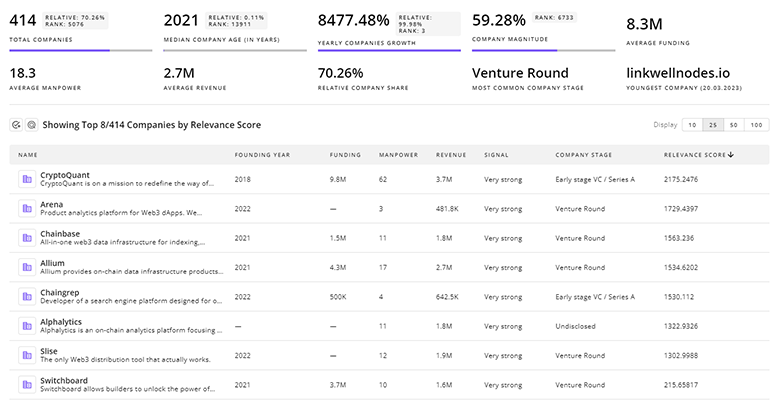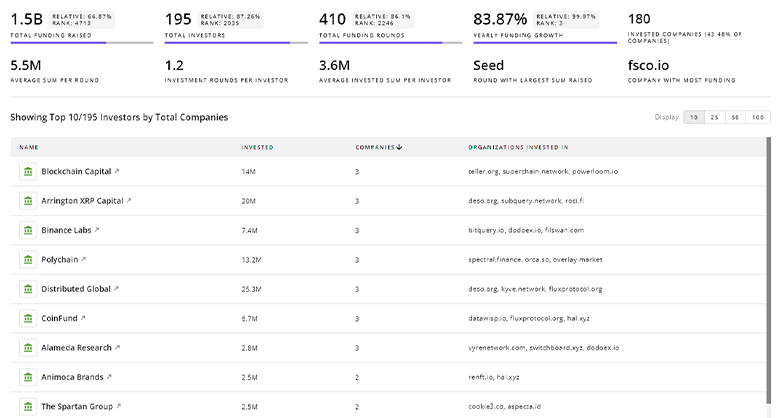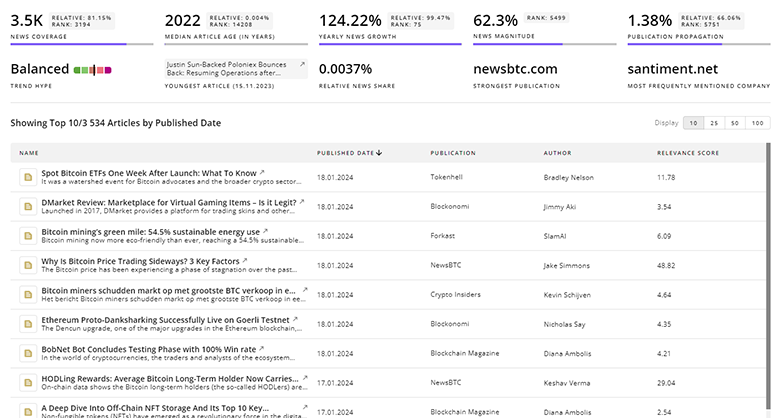
Space Launch Vehicles Report
: Analysis on the Market, Trends, and TechnologiesThe space launch vehicles sector is under significant financial and technological evolution, as evidenced by the involvement of 1,346 companies with combined annual revenue approaching USD 25.7 billion. The market is marked by rapid shifts in launch methodologies and increasing adoption of reusable systems, alongside evolving regulatory and operational challenges that are reshaping both cost structures and operational models.
68 days ago, we last updated this report. Notice something that’s not right? Let’s fix it together.
Topic Dominance Index of Space Launch Vehicles
To gauge the influence of Space Launch Vehicles within the technological landscape, the Dominance Index analyzes trends from published articles, newly established companies, and global search activity
Key Activities and Applications
- Satellite Deployment: The primary role of space launch vehicles is the deployment of satellites for communication, Earth observation, navigation, and defense. This includes rideshare services and dedicated launches for small satellites and cubesats (Research and Markets).
- Scientific Research: Launch vehicles support R&D missions and scientific payloads by enabling experiments in microgravity and providing platforms to test new satellite technologies such as remote sensing and environmental monitoring.
- Government and Military Applications: Missions include resupply efforts, reconnaissance and secure communications, backed by multi-year governmental contracts to support both routine and critical missions.
Emergent Trends and Core Insights
- Reusable Launch Systems: Increasing investment in reusable vehicle technology is reducing launch costs while increasing access frequency.
- Technological Integration: Recent advancements in AI-driven operational planning, 3D printing for rocket components and hybrid propulsion systems are enhancing system efficiency and lowering production cycles (Global Market Insights).
- Environmental and Operational Safety: Growing concern regarding space debris and greenhouse gas emissions is prompting the industry to adopt alternative, green propulsion technologies and stricter operational safety protocols (MarketResearch.com).
Technologies and Methodologies
- Propulsion Technologies: Advances in liquid, solid, hybrid, and electric propulsion are central to current innovations, with breakthroughs like cryogenic engines and reconditioned first stages significantly reducing flight costs.
- Material Science and Manufacturing: The utilization of lightweight composites and additive manufacturing (3D printing) is enhancing payload capacity, reliability, and cost-effectiveness of launch systems.
- Operational Methodologies: Enhanced mission management through automated software, real-time telemetry, and integrated regulatory support ensure timely and precise satellite deployments, further supported by in-orbit services and agile payload integration strategies .
Space Launch Vehicles Funding
A total of 279 Space Launch Vehicles companies have received funding.
Overall, Space Launch Vehicles companies have raised $58.0B.
Companies within the Space Launch Vehicles domain have secured capital from 1.3K funding rounds.
The chart shows the funding trendline of Space Launch Vehicles companies over the last 5 years
Space Launch Vehicles Companies
- Exolaunch – A global leader in satellite launch integration and deployment, Exolaunch specializes in rideshare and dedicated launch services alongside proprietary satellite separation systems that have supported 529 customer satellites over 35 missions.
- Scorpius Space Launch Company – Specializing in low-cost space launch vehicles and commercial mission solutions, Scorpius Space Launch Company leverages innovative composite technologies and mission-specific design strategies to serve government and private customers.
- TLON Space – Focused on creating ultralight small launch vehicles, TLON Space’s Aventura I is designed to be the lightest orbital rocket in the world and caters specifically to the smallsat market with a focus on cost-efficient, frequent launches.
- HyImpulse – A German company developing suborbital and orbital launch services with hybrid propulsion, HyImpulse is noted for its successful testing of a full-scale, 75 kN hybrid motor and its Small Launcher 1 (SL1) designed for small satellite missions.
- Starfighters Space – Operating a unique fleet of F-104 fighter jets, Starfighters Space provides air-launch capabilities for small payloads into orbit, marking an innovative and cost-effective approach to satellite deployment from the Southern United States.
Get detailed analytics and profiles on 1.3K companies driving change in Space Launch Vehicles, enabling you to make informed strategic decisions.

1.3K Space Launch Vehicles Companies
Discover Space Launch Vehicles Companies, their Funding, Manpower, Revenues, Stages, and much more
Space Launch Vehicles Investors
TrendFeedr’s Investors tool provides an extensive overview of 1.9K Space Launch Vehicles investors and their activities. By analyzing funding rounds and market trends, this tool equips you with the knowledge to make strategic investment decisions in the Space Launch Vehicles sector.

1.9K Space Launch Vehicles Investors
Discover Space Launch Vehicles Investors, Funding Rounds, Invested Amounts, and Funding Growth
Space Launch Vehicles News
Explore the evolution and current state of Space Launch Vehicles with TrendFeedr’s News feature. Access 1.8K Space Launch Vehicles articles that provide comprehensive insights into market trends and technological advancements.

1.8K Space Launch Vehicles News Articles
Discover Latest Space Launch Vehicles Articles, News Magnitude, Publication Propagation, Yearly Growth, and Strongest Publications
Executive Summary
The analysis of the space launch vehicles sector reveals a complex landscape marked by significant technological progress, competitive restructuring, and evolving market dynamics. Despite financial and regulatory challenges, the integration of advanced propulsion and manufacturing methodologies is lowering launch costs and increasing mission frequency. Continued innovation and increased collaboration—both in government and private sectors—will be essential for sustaining growth and ensuring sustained access to space for a range of critical applications.
We're looking to collaborate with knowledgeable insiders to enhance our analysis of trends and tech. Join us!








